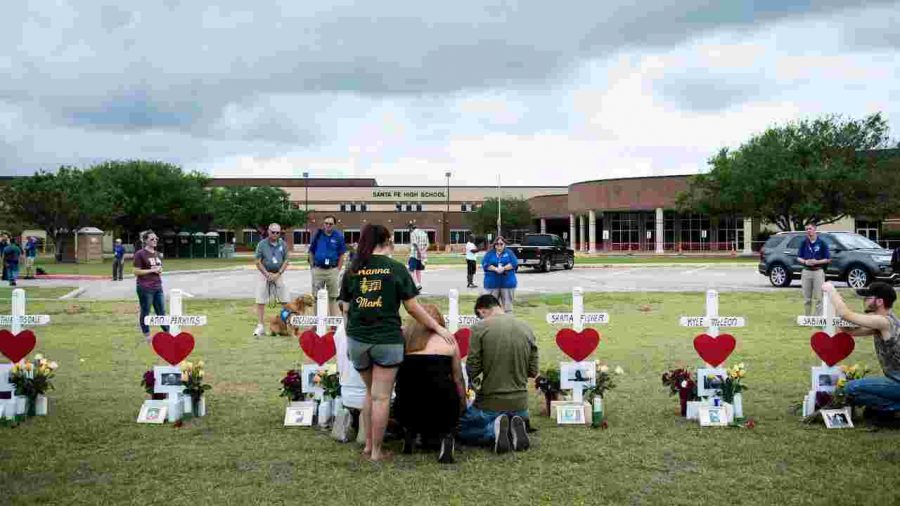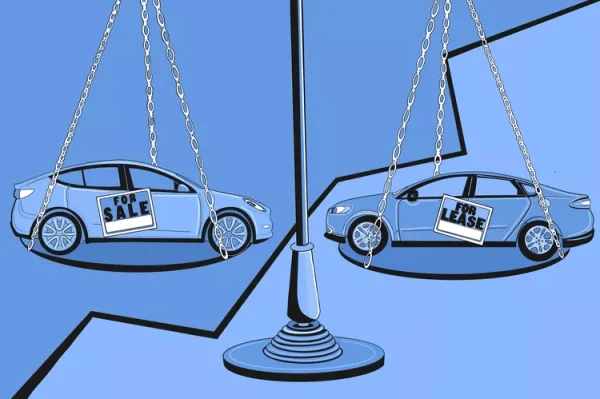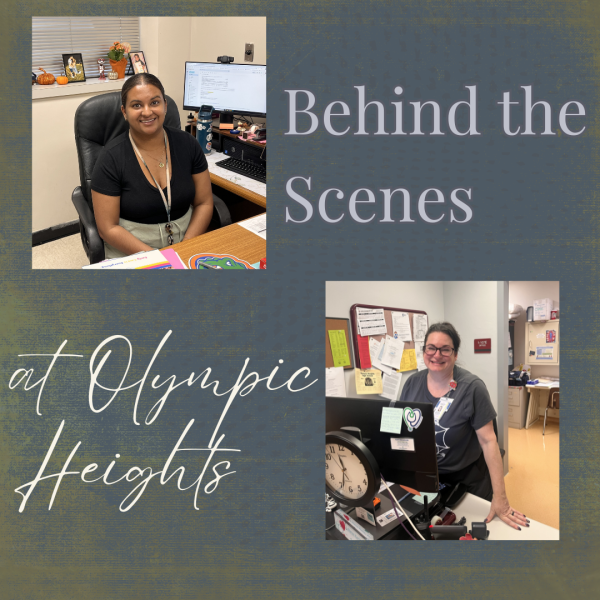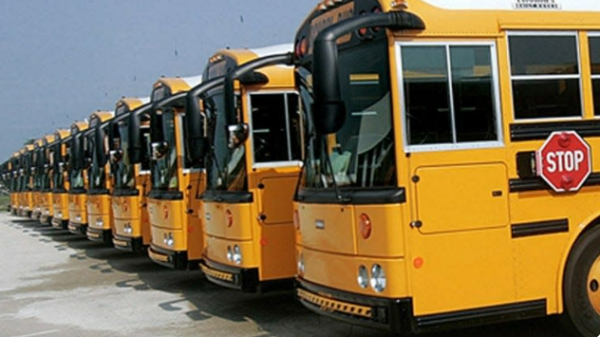Responses to School Shootings Vary Depending on Politics
A makeshift memorial to the 10 murdered Sante Fe High School students was erected outside the school.
Shooting after shooting after shooting. They have become so prevalent lately that it seems as if they are transpiring daily. Even as this story is being written, more shootings are materializing, as evidenced by a shooting at an Indiana middle school on May 25. From Sandy Hook to Orlando to Las Vegas to Parkland, massacres targeting even young, innocent children have enveloped the nation in recent years, sparking tense debate over the strictness of gun laws.
The latest massive outbreak occurred on May 18 at Santa Fe High School southeast of Houston, Texas. A 17-year-old student named Dimitrios Pagourtzis armed with a shotgun and a .38 revolver smuggled under his coat opened fire on his own high school campus, killing 10 people and injuring 10 others. Each shooting had varying responses, but the majority of demands were for change in some shape or form.
The recent Texas shooting has been frequently compared to the Marjory Stoneman Douglas High School shooting of February 14, 2018, which was carried out by former student Nicholas Cruz in Parkland, Florida. leaving 17 people dead. It is important to note that the reaction in Florida was definitely more intense than the one in Texas. Post-Parkland Florida was dominated by outrage regarding gun control with student activists like David Hogg and Emma Gonzalez pushing for school security and gun reform. However, the reaction in Texas was not so revolutionary.
“Florida is a swing state,” says Calvin Jillson, a professor of political science at Southern Methodist University in Dallas. “You start with the understanding that Florida is a purple state in which Democrats and Republicans are both competitive. Texas is a deep-red state, in which the Republican Party is in complete and total control. They don’t feel that partisan electoral heat.”
Essentially, Texas (like many other states in the South) is controlled by Republicans who support the Second Amendment, which protects a person’s right to bear arms, so there was little anti-gun fervor or backlash following that shooting. There is no widespread vocal pressure and activism from the families and students themselves, with the exception of a handful of students who do agree there needs to be some change. Guns are hardwired into Texans’ brains; there is little indication that gun reform will gain much traction in such a conservative state.
In contrast, the Parkland shooting prompted a successful push for gun control. Florida Governor Rick Scott signed into law several measures, including raising the minimum gun-purchase age and adding a three-day waiting period to purchase a gun. Because the shooting happened in a suburban, diverse community, it ignited an enormous outburst from Stoneman Douglas students, as well as other middle and high school students across the nation. They staged walkouts, political rallies, and public interviews.
For example, they planned the March For Our Lives on March 24, a national march to Washington to urge lawmakers to pass gun control measures. Stoneman Douglas students also met with President Donald Trump at the White House after the shooting. The president has even backed a controversial National Rifle Association (NRA) push to arm teachers in the classroom to protect students, but no press for action has been made.
Some gun rights advocates do not believe that gun reform is the solution to our country’s problems. Republican leaders in Texas, including Governor Greg Abbott, nationally talk about a need to act — but not by restricting guns. Instead, many pro-gun supporters like Abbot have argued for redesigning school buildings, arming teachers, and promoting safer gun storage at home to keep firearms out of the hands of children and teenagers.
One similar opinion is illustrated by Sante Fe High School senior Monica Bracknell, who knew one of the victims. She claims, “That kid was 17. He’s not able to buy a gun anyway. It’s not like a gun-law issue. This kid is obviously mentally unstable and he knew that there were flaws in the school system to get into the rooms.” Like many in south, rural, and Republican states, she believes that this is a mental-health problem, not a gun-law problem, and that there should be no laws restricting guns. Bracknell thinks that the country should focus on improving and preventing mental health disorders.
An even more conservative view is upheld by 69-year-old Texas citizen Robert Ross, who has lived in Santa Fe all his life and has a nephew who once played football with the gunman. Ross believes that the solution to school violence is not gun control, but faith. He blames the shooting on what he calls a cultural decay epitomized by legal abortion, gay marriage and the separation of church and state.
Legislation favoring gun reform does not seem to be in the works in Texas. On the CNN program “State of the Union,” Dan Patrick, the Republican lieutenant governor of Texas, called on parents to strictly control their guns to keep them out of the hands of children, but he did not call for any specific legislation to enforce that. This is significant because the shooter used his father’s gun to murder and injure over 20 innocent civilians; he never bought the gun himself because he was too young to purchase one.
Floridian student activists seem to care immensely about gun reform in America. The Never Again movement, a gun control advocacy group formed by Hogg and fellow Parkland shooting survivors, continues to push for stricter gun laws. They want to ban assault weapons, prohibit high-capacity magazines, close background check loopholes, raise the federal minimum gun ownership and possession age to 21, and create other specific solutions to help reduce gun violence with mentally ill individuals.
On the flip side, the National Rifel Association (NRA) thinks that such a ban to assault weapons would be the first step in confiscating the more commonly owned, handheld weapons. But David Hogg insists the Never Again Movement “is not trying to take away your guns.” Hogg, like many other students in this violence-inflicted day and age, fears the devastation that guns can bring during school shootings. “We’re trying to take back our lives,” he told the Outline, a digital media outlet. “Just as much as you have a right to own a weapon, we have a right to liberty, we have the right to peace, and we have the right to live.”
On May 25, Hogg and other gun violence activists staged a “die in” protest at a Coral Springs Publix in response to Publix’s financial donations to a gubernatorial candidate (Adam Putnam) who once boasted he was a “proud NRA sellout.” Right before the protest was to begin, Publix decided to suspend all corporate political contributions. This demonstrates how ordinary individuals can influenceinspire change by protesting against what they find as unfair.
The sad fact is, these shootings have become so commonplace that many children fear going to school. Not only have schools started practicing active shooter drills and huddling through lockdowns, but students themselves are used to hearing about shootings across the U.S. and throughout our globalized world.
One video interview of a Santa Fe student named Paige Curry conducted by an ABC news station gripped social media audiences as a visualization of how children today expect violence and feel unsafe in their own schools. The reporter asked the young girl if there was any part of her that thought the incident was not real and could not be happening. “No,” Curry responded. “It’s been happening everywhere. I felt — I’ve always kind of felt like eventually it was going to happen here, too.”









